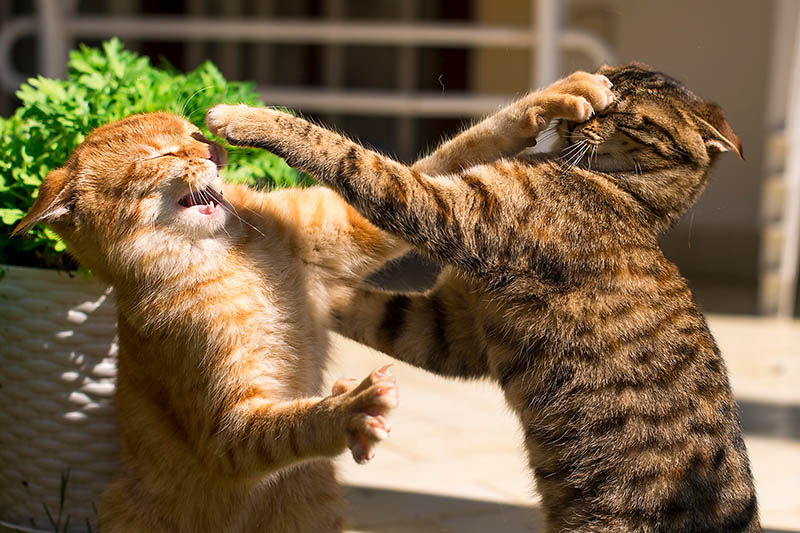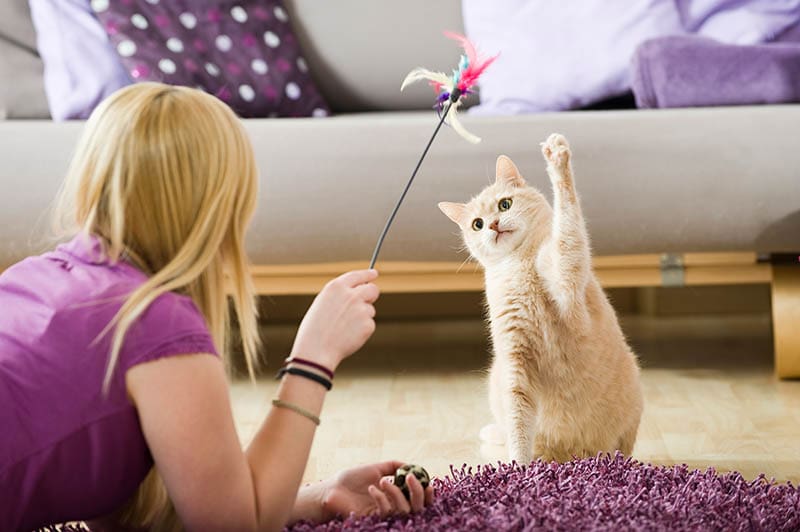8 Great Ideas on How to Calm an Aggressive Cat – Understanding Cat Behavior
Updated on

Maybe you’ve recently adopted a cat with some behavior issues. Maybe your cat suddenly started showing unwanted behavior. Or maybe you’re handling a cat that isn’t yours. In any case, dealing with a spicy kitty isn’t easy. Cats don’t hold back when upset. They have claws and are not afraid to use them.
Here’s the good news: cat aggression is 100% manageable, but you must be willing to do the work. Finding the cause won’t be easy, but you’re not alone. Cat owners everywhere have had to deal with war-like cat behavior. If they figured it out, you can too!
Identify the Type of Aggression
Fixing your cat’s aggression will take time and effort on your part. Identifying the type of aggression your cat shows is a good start. Doing so will help you understand why your cat is stressed and find the best plan of action to treat the problem. Here are the most common types of cat aggression:
- Predatory (Play) Aggression: When your cat shows its natural hunting ability during a play session, perhaps too well.
- Overstimulation Aggression: When an owner pets their cat so much, the cat becomes overstimulated and bites or scratches the owner.
- Redirected Aggression: When a frustrated or scared cat takes its frustration out on an unrelated object, pet, or person.
- Fear Aggression: When a cat feels threatened and attacks out of fear
- Hormonal (Tomcat) Aggression: When an intact or maternal cat attacks an animal or person
- Pain-Induced Aggression: When a cat in pain attacks an animal or person to avoid touch, movement, or anything that can increase the pain.
- Territorial Aggression: When a cat attacks an animal or person to show dominance and establish territory. Cats away from home temporarily can induce territorial aggression (i.e., vet visit, groomer, cat hotel).
So, cats act offensively for several reasons, and sometimes the behavior is completely warranted. But sometimes, this isn’t the case, and it can even be life-threatening for the cat or another pet in the worst-case scenario.
No one wants to find themselves in this situation. To help, we’re listing eight ideas for keeping your cat (and home) calm and safe.
The 8 Great Ideas on How to Calm an Aggressive Cat
1. Provide a Cat-Friendly Space

Cats need a place to run, scratch, climb, bite, and do whatever they want. This is a space where they can access their natural instincts without holding back. If you already have one for your cat, you’re already one step ahead of the game.
Start by embellishing a simple corner in the living room. Include cat trees, shelves, toys, and maybe some catnip if your cat likes it. Ensure your cat has a place to climb, scratch, and lounge. Cats love being vertical, so the higher the shelves, the better.
2. Use a Synthetic Calmer
Feliway is a synthetic hormone that mimics the natural pheromone a mama cat gives off around her kittens. It helps promote harmony and reduce aggression, inappropriate urination, and other unwanted reactions. Feliway is an excellent choice for keeping your cat relaxed during significant changes in routine, like a new house or baby.
Not every cat responds to Feliway, but many owners have had success with it, so it’s worth a try.
3. Separate Pets

Many owners mistakenly introduce two cats prematurely, causing fights. If your cat is attacking another pet, it’s wise to separate both pets and reintroduce them slowly at a later time. Your cat only has so much territory to share, and new pets won’t be accepted as quickly as we think.
This can also occur when a pet visits a vet and comes home with a cone and other scents that the other cat doesn’t like. Your cats may know each other, but a change in smell can be alarming to your cat. Temporary separation is a good idea in this scenario. In extreme cases, you may have to reintroduce the cats as if they were strangers.
4. Expand Territory
Many cat owners hide their feisty cats in a room so that they don’t hurt anyone, which is understandable. The problem with hiding your cat is your cat doesn’t have a way to expend energy. All that built-up energy has to go somewhere, which usually results in more aggression or other destructive behavior.
If you need to keep your cat enclosed, try expanding its territory so it has more space to burn energy. Offer toys, cat trees, and other methods for your cat to use its energy healthily.
5. Play With Your Cat

Speaking of burning energy, playing with your cat is an excellent way to redirect unwanted behavior. Instead of taking its frustration out on your ankles, your cat can attack a toy bird or mouse. Your cat will be exhausted, and your relationship with each other will strengthen.
6. Try Catnip
At first glance, catnip may not seem to offer much for an aggressive cat. The high your cat experiences only lasts about 10 minutes, and that’s if your cat feels the effect. But after a euphoric high, some cats mellow into a couch lock for a little while, so it could help soothe your kitty.
If catnip doesn’t work for your cat, you can try other safe herbs, such as Tatarian honeysuckle, valerian, and silvervine.
7. Visit the Vet

If you’ve tried everything and nothing works, it may be time to take your cat to the vet, especially if the aggression appears out of nowhere.
Cognitive decline and pain can increase a cat’s irritability and anxiety, usually resulting in aggressive behavior. Some indicators your cat is in pain include hiding from people, avoiding touch, and lashing out when you touch your cat in a specific area.
Cats are great at hiding pain, but sometimes the pain is too much. To be sure, visit the vet for a full-body examination.
8. Spay/Neuter Your Cat
If your cat isn’t neutered or spayed, this could be the reason your cat is lashing out. This is especially true for intact male cats. Intact male cats have hormones that cause sexually dimorphic behaviors. It’s why we see tomcats fighting but not with female cats.
It’s worth noting that this aggression usually has nothing to do with people. However, neutering and spaying will help reduce aggression toward other cats.
Conclusion
So, does this mean you can’t keep your cat anymore? No, not necessarily. The truth is that many cat owners have struggled to find a solution to their cat’s aggression. It’s not easy handling a fluffy force with claws. But it doesn’t mean you have to give up on your cat. All it means is you have to put your investigator hat on and think. Ask yourself if anything changed recently that could be upsetting your cat.
If nothing comes to mind, we encourage you to talk to your vet or a cat behaviorist. Cats don’t want to be mean. When they are, it’s usually a sign they’re trying to tell us something. What do you think your cat is trying to say to you?
Featured Image Credit: Frauke Riether, Pixabay












